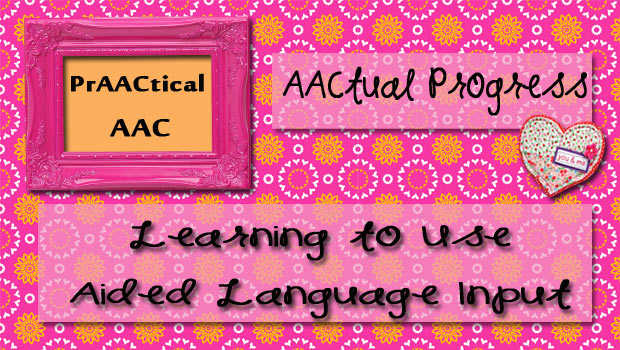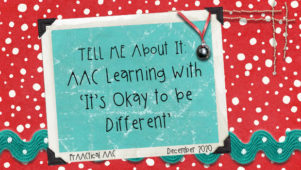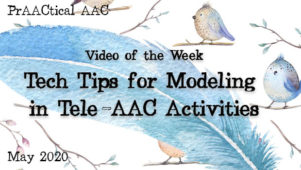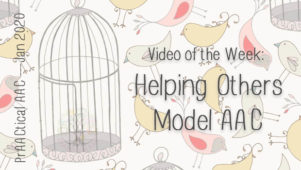AACtual Progress: Learning to Use Aided Language Input

The only thing better than watching someone who uses AAC get the hang of it, is having the privilege of seeing this develop in future SLPs. Turn up the music, it’s time for the Happy Dance! I had the distinct pleasure this week of watching some of our graduate student clinicians ‘get it’ with respect to using the Strategy of the Month, Aided Language Input. It’s taken a few weeks, but then again they only see their AAC friends for a short amount of time.
–
Here are a few things we learned along the way.
–
1. It takes time to get good at this. We’re speaking pidgin AAC until we get fluent, so just keep at it. Give yourself permission to be halting at first. Keep at it and the fluency will come.
2. It helps to start small. If the communication aid, SGD, or app is complex, don’t try to tackle everything at once. Get comfortable with modeling using the main pages or screens first, then move onto other places where vocabulary is stored.
3. Along those lines, it helps to start off by modeling only core words in the sentence. Those words are already highly familiar to you and they are generally words that are easy to read. That makes it a bit easier to develop a smooth motor pattern for saying those words so that you can move from hunt-&-peck to slide-&-glide.
4. Using aided language input helps with our oral language. As interventionists, we noticed that using it makes us choose our words carefully. It also slows us down which really benefits our AAC friends who have language processing difficulties.
5. Visual cues can be very helpful in reminding us to use the strategy. A quick gesture from a colleague or a sticky note helped us get back on track when we started to say things without the AAC. We use visual reminders with folks who use AAC, so this was a good opportunity to practice what we preach.
6. Using aided language input helped us pick up on flaws in the programming or design of the AAC system. We spotted a couple of errors in the color coding, some typos in the text, a misplaced modifier, and things like that.
7. It’s contagious! The more we used aided language input, the more we saw other people using it as well. In this case, more is better.
8. Kids love it. They get a real kick out of seeing us in the role of learner. Sometimes they would happily shove us out of the way so that they could help us find a word. We’ll take that kind of motivation any day of the week.
–
Thanks to our tenacious and talented graduate students for inspiring this post and always teaching us something new.
–
–
Other posts and PrAACtical information on Aided Language Input
Filed under: Strategy of the Month
Tagged With: aided language input, intervention
This post was written by Carole Zangari





2 Comments
Great article!
I found ALI one of the best stratgies for helping children and adults engage without a barrier of needing child reponse first. I was a special school tecaher and now am a consultant supporting schools. I had one question to ask you. I had an outline fo the preferred range of vocab to inlcude on a board (x amount of verbs, adjectives etc). Does this sound familiar to you. I wanted to share with a school today and could not find it oin my notes so I am working form memory.